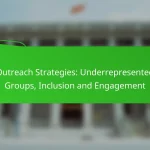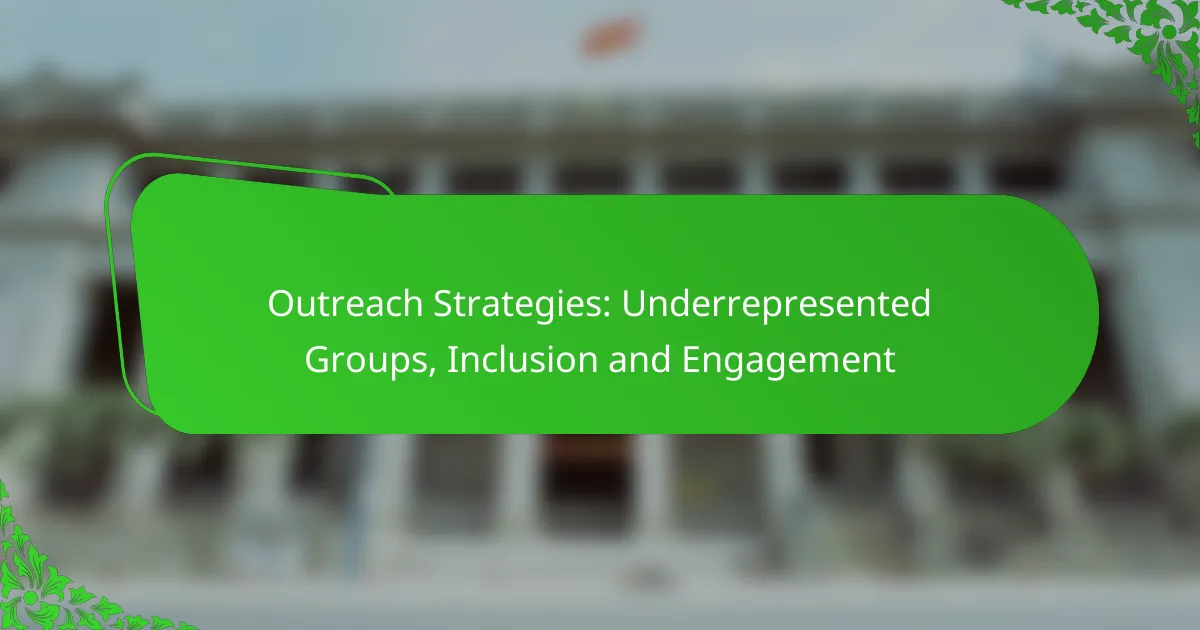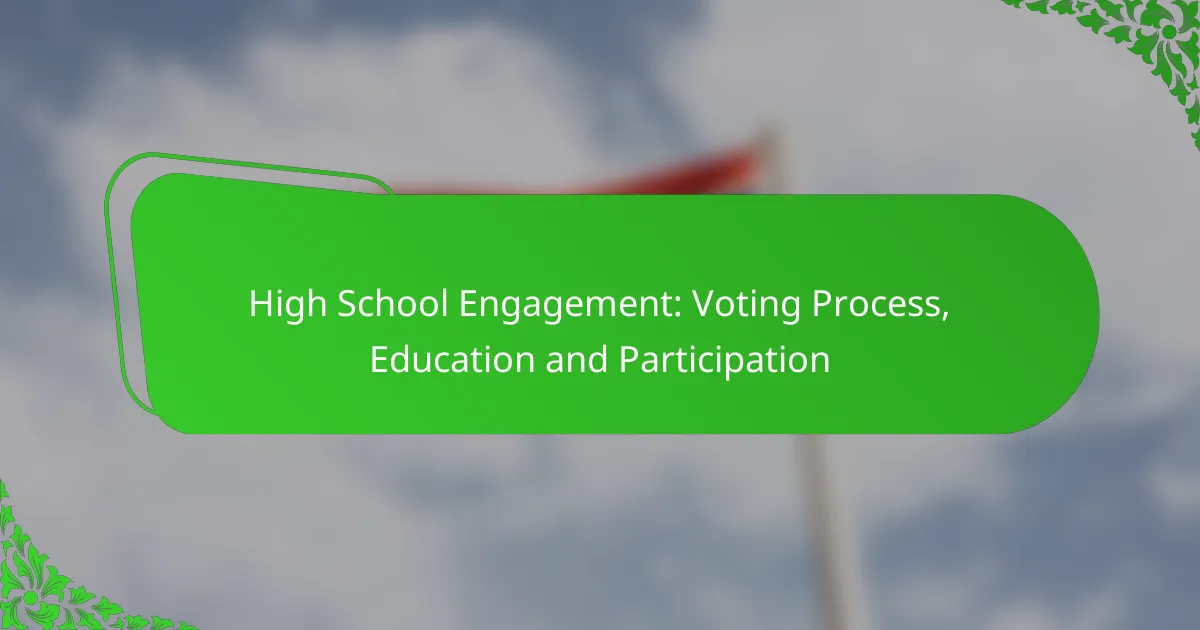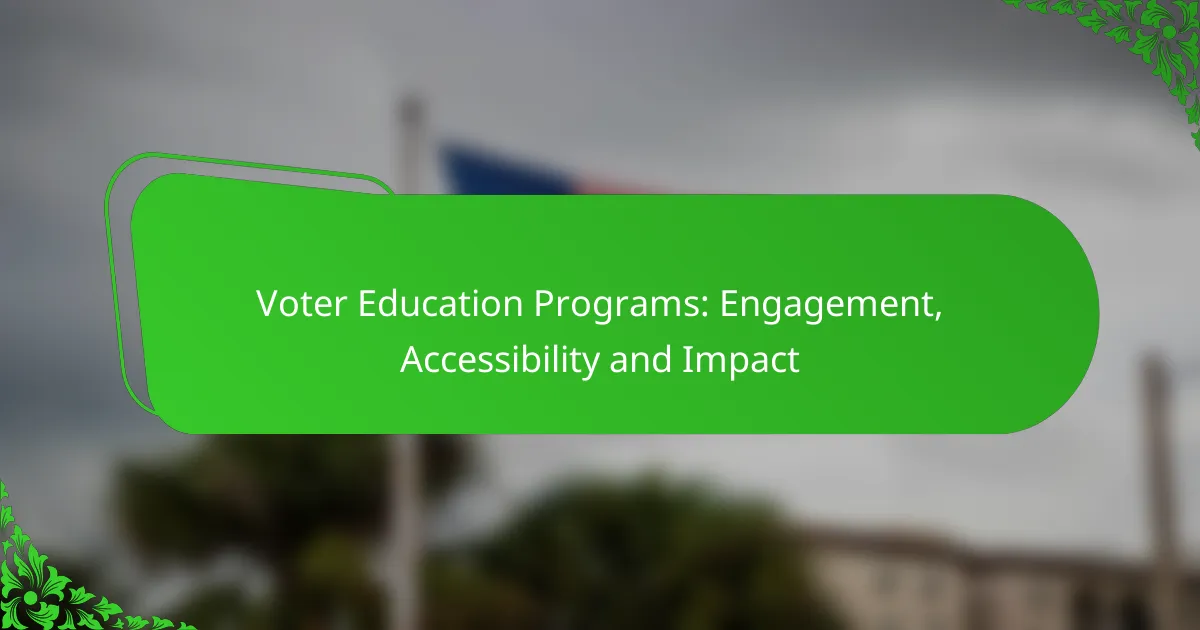Effective outreach strategies for underrepresented groups are essential for fostering inclusion and engagement within communities. By prioritizing tailored approaches that build relationships and leverage technology, organizations can create supportive environments that encourage diverse participation. Implementing targeted strategies that address unique needs not only amplifies voices but also cultivates a culture of belonging.
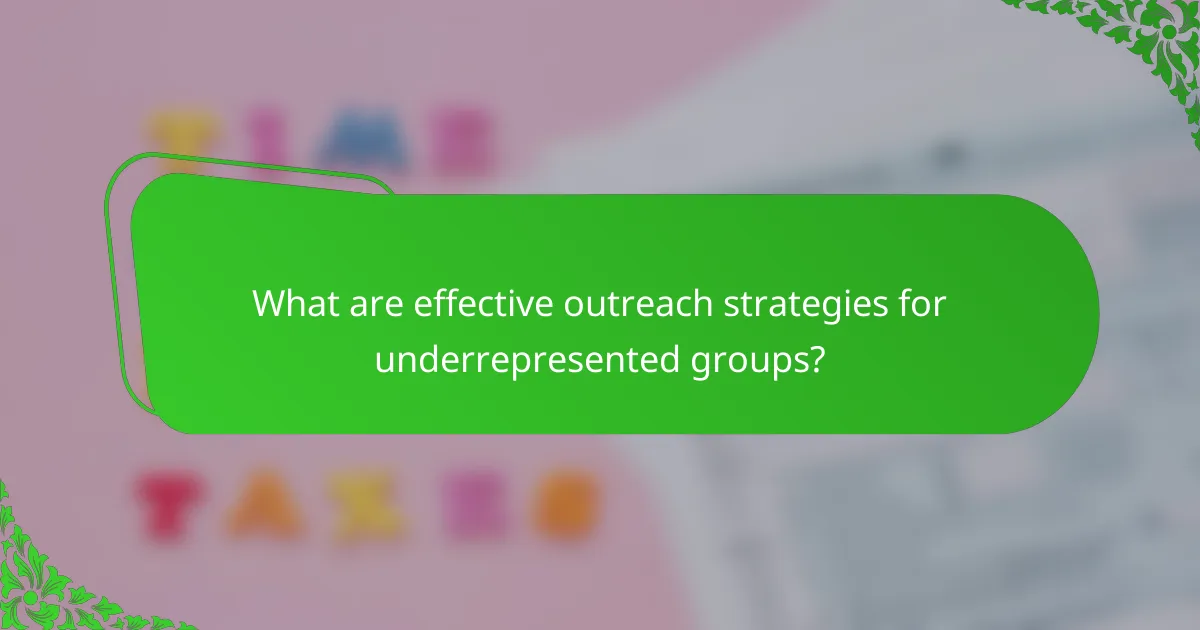
What are effective outreach strategies for underrepresented groups?
Effective outreach strategies for underrepresented groups involve tailored approaches that foster inclusion and engagement. These strategies prioritize building relationships, leveraging technology, and creating supportive environments that encourage participation.
Community partnerships
Establishing community partnerships is crucial for reaching underrepresented groups. Collaborating with local organizations, schools, and advocacy groups can enhance credibility and facilitate access to diverse populations. These partnerships can also provide valuable insights into the specific needs and preferences of the community.
Consider co-hosting events or initiatives that align with the goals of both parties. This can lead to shared resources, increased visibility, and a broader impact. Always ensure that the partnership is mutually beneficial and respects the community’s values and culture.
Targeted social media campaigns
Targeted social media campaigns can effectively engage underrepresented groups by using platforms they frequent. Tailoring content to reflect the interests and experiences of these communities can enhance relatability and engagement. Utilize demographic targeting features to reach specific groups based on location, interests, and behaviors.
Incorporate visuals and storytelling to create compelling narratives that resonate. Regularly analyze engagement metrics to refine strategies and ensure the content remains relevant and impactful.
Inclusive event planning
Inclusive event planning is essential for attracting underrepresented groups. This involves considering accessibility, cultural sensitivities, and diverse representation in event programming. Ensure venues are accessible and provide materials in multiple languages if necessary.
Engage community members in the planning process to gather feedback and ideas. This not only fosters ownership but also ensures that the event meets the needs of the targeted audience. Promote the event through channels that are popular within the community to maximize attendance.
Mentorship programs
Mentorship programs can significantly support underrepresented groups by providing guidance and networking opportunities. Pairing individuals with mentors who share similar backgrounds or experiences can foster trust and encourage personal and professional growth.
Structure the program to include regular check-ins and goal-setting sessions. This helps mentees stay motivated and accountable. Promote the program through community organizations to reach potential participants effectively.
Collaborative workshops
Collaborative workshops offer hands-on learning experiences that can engage underrepresented groups. These workshops should focus on relevant skills or topics that resonate with the community’s interests and needs. Involve community members in designing the curriculum to ensure it is culturally appropriate and impactful.
Utilize local experts or leaders to facilitate workshops, as this can enhance credibility and relatability. Provide opportunities for participants to share their experiences and insights, fostering a sense of community and collaboration.
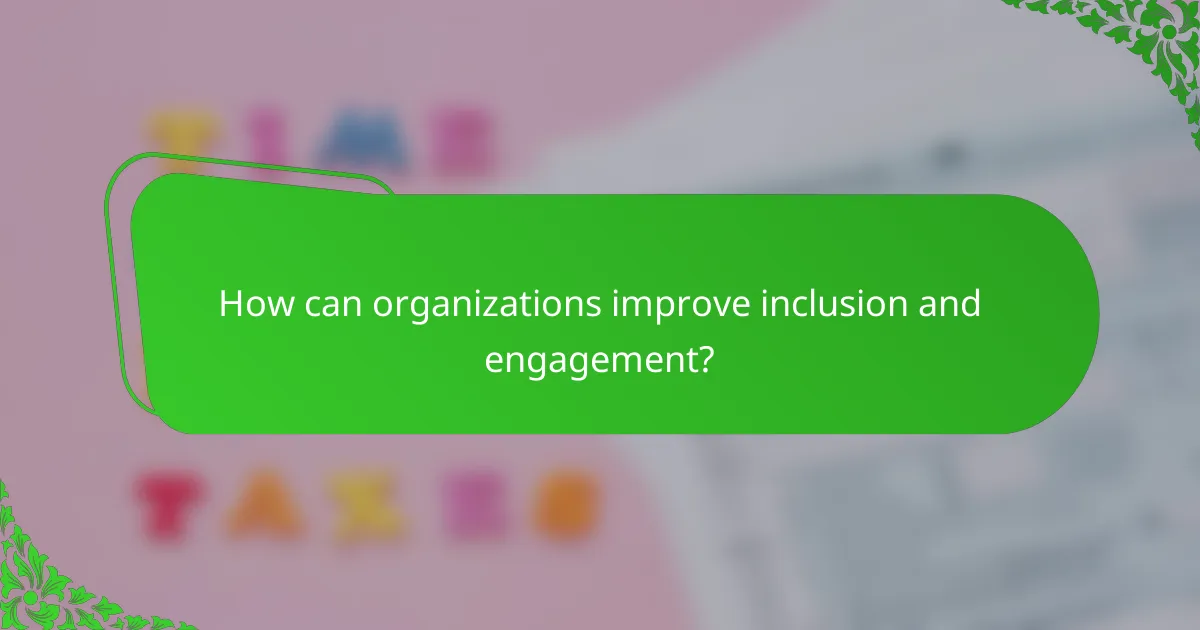
How can organizations improve inclusion and engagement?
Organizations can enhance inclusion and engagement by implementing targeted strategies that address the unique needs of underrepresented groups. This involves creating an environment where diverse voices are heard and valued, fostering a culture of belonging and participation.
Diversity training programs
Diversity training programs are essential for raising awareness about the importance of inclusion and understanding the challenges faced by underrepresented groups. These programs can include workshops, seminars, or online courses that educate employees on topics such as unconscious bias, cultural competence, and inclusive practices.
To be effective, training should be ongoing rather than a one-time event. Organizations can consider integrating diversity training into onboarding processes and offering refresher courses annually. Engaging activities, such as role-playing scenarios or group discussions, can enhance learning and retention.
Feedback mechanisms
Establishing robust feedback mechanisms allows organizations to gather insights from employees about their experiences and perceptions of inclusion. This can be achieved through anonymous surveys, focus groups, or suggestion boxes, enabling individuals to voice their concerns and ideas without fear of repercussions.
It’s crucial to act on the feedback received to demonstrate that the organization values employee input. Regularly communicating changes or improvements based on feedback can strengthen trust and encourage further participation in the process.
Accessible communication channels
Accessible communication channels ensure that all employees can engage with organizational messages and initiatives. This includes providing information in multiple formats, such as written, audio, and visual, to accommodate diverse needs and preferences.
Organizations should also consider language accessibility, offering materials in the primary languages of their workforce. Regularly reviewing and updating communication strategies can help identify barriers and improve overall engagement with underrepresented groups.
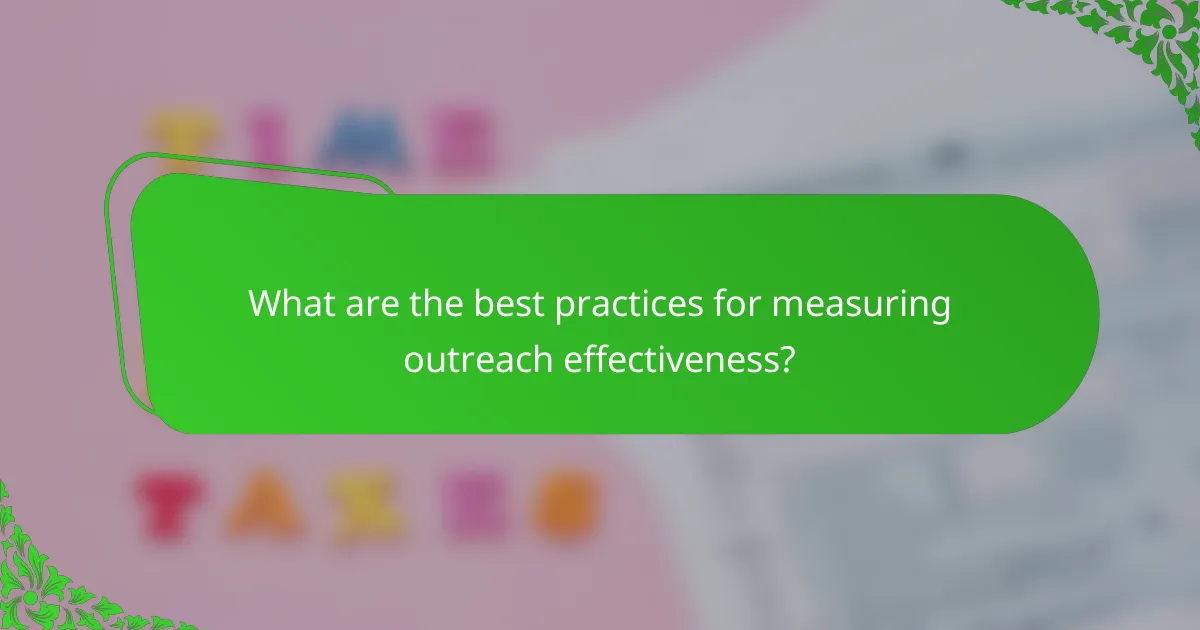
What are the best practices for measuring outreach effectiveness?
Measuring outreach effectiveness involves assessing how well your strategies engage underrepresented groups. Key practices include utilizing data analytics, gathering feedback through surveys, and analyzing engagement metrics to refine your approach.
Data analytics tools
Data analytics tools are essential for tracking outreach effectiveness by providing insights into demographic engagement and behavior patterns. Tools like Google Analytics and social media insights can help identify which channels are most effective in reaching underrepresented groups.
When selecting a data analytics tool, consider factors such as ease of use, integration capabilities, and the specific metrics you want to track. For example, tracking website traffic sources can reveal which outreach efforts are driving the most visitors.
Surveys and feedback forms
Surveys and feedback forms are valuable for directly gathering input from your target audience. These tools can help assess perceptions of your outreach efforts and identify areas for improvement. Aim for concise surveys that take no more than 5-10 minutes to complete.
Include both quantitative questions, like rating satisfaction on a scale, and qualitative questions that allow for open-ended responses. This combination provides a more comprehensive understanding of participant experiences and needs.
Engagement metrics
Engagement metrics measure how actively your audience interacts with your outreach initiatives. Common metrics include attendance rates at events, participation in discussions, and social media engagement levels. Tracking these metrics helps gauge the effectiveness of your outreach strategies.
Establish benchmarks for success, such as aiming for a participation rate of at least 30% for events or a certain number of interactions per post on social media. Regularly reviewing these metrics allows for timely adjustments to enhance engagement with underrepresented groups.
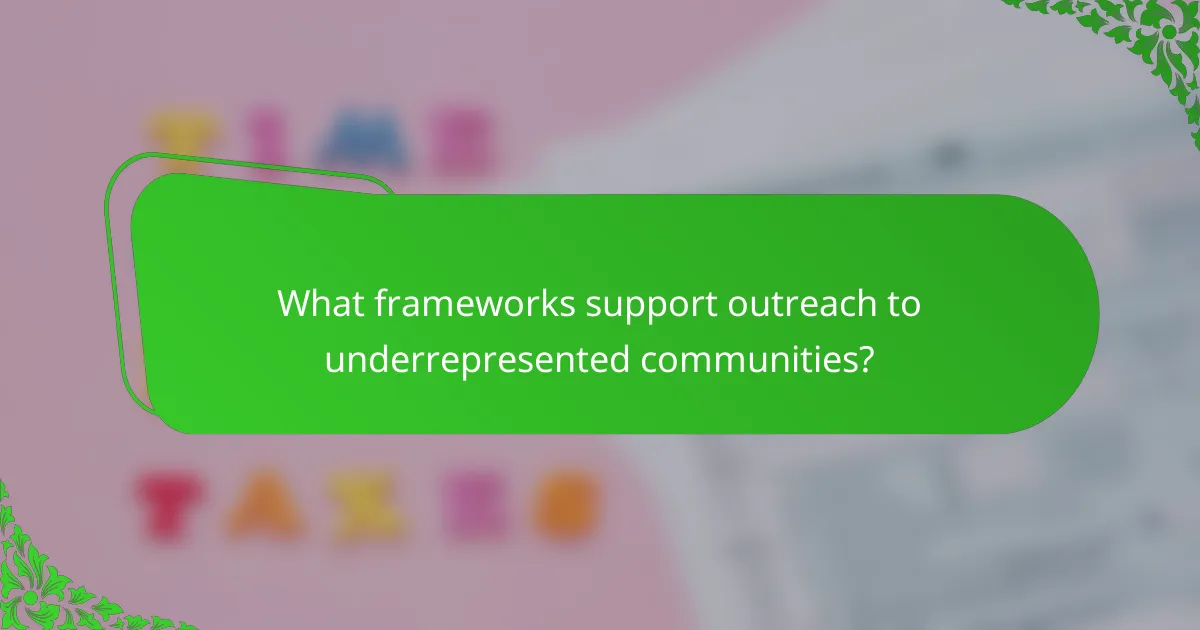
What frameworks support outreach to underrepresented communities?
Outreach to underrepresented communities can be effectively supported by frameworks that prioritize equity and inclusion, as well as community engagement models. These frameworks provide structured approaches to ensure that diverse voices are heard and included in decision-making processes.
Equity and inclusion frameworks
Equity and inclusion frameworks focus on creating fair opportunities for all individuals, particularly those from marginalized backgrounds. These frameworks often involve assessing existing disparities and implementing strategies to address them, such as targeted outreach programs and inclusive policies.
Key steps include identifying barriers that underrepresented groups face and developing tailored initiatives to overcome these challenges. For example, organizations might offer scholarships or mentorship programs specifically designed for individuals from low-income backgrounds or minority communities.
Community engagement models
Community engagement models emphasize building relationships with underrepresented groups to foster trust and collaboration. Effective engagement requires understanding the unique needs and perspectives of these communities, often through participatory methods such as focus groups or community forums.
To implement these models, organizations should prioritize transparency and regular communication. Engaging community leaders as partners can enhance outreach efforts, ensuring that initiatives are culturally relevant and responsive to local contexts. For instance, involving local nonprofits in planning can lead to more effective outreach strategies that resonate with the community.

What role do local organizations play in outreach?
Local organizations are crucial in outreach efforts aimed at underrepresented groups, as they facilitate connections and foster trust within communities. These organizations often have established relationships and a deep understanding of the specific needs and challenges faced by these groups.
Resource sharing
Local organizations can provide valuable resources that enhance outreach initiatives. This includes access to funding opportunities, educational materials, and training programs tailored to the community’s needs. By collaborating with these organizations, outreach efforts can be more effective and sustainable.
For example, a local nonprofit might offer workshops on financial literacy, which can be integrated into outreach programs to empower participants with essential skills. Additionally, sharing resources can help avoid duplication of efforts and ensure that services are complementary.
Local knowledge and insights
Local organizations possess unique insights into the cultural and social dynamics of their communities. This knowledge is vital for designing outreach strategies that resonate with underrepresented groups. Understanding local customs, languages, and barriers can significantly improve engagement and participation rates.
For instance, a community-based group might highlight specific cultural events or traditions that can be leveraged to promote outreach activities. Engaging local leaders and influencers can also enhance credibility and encourage wider participation.
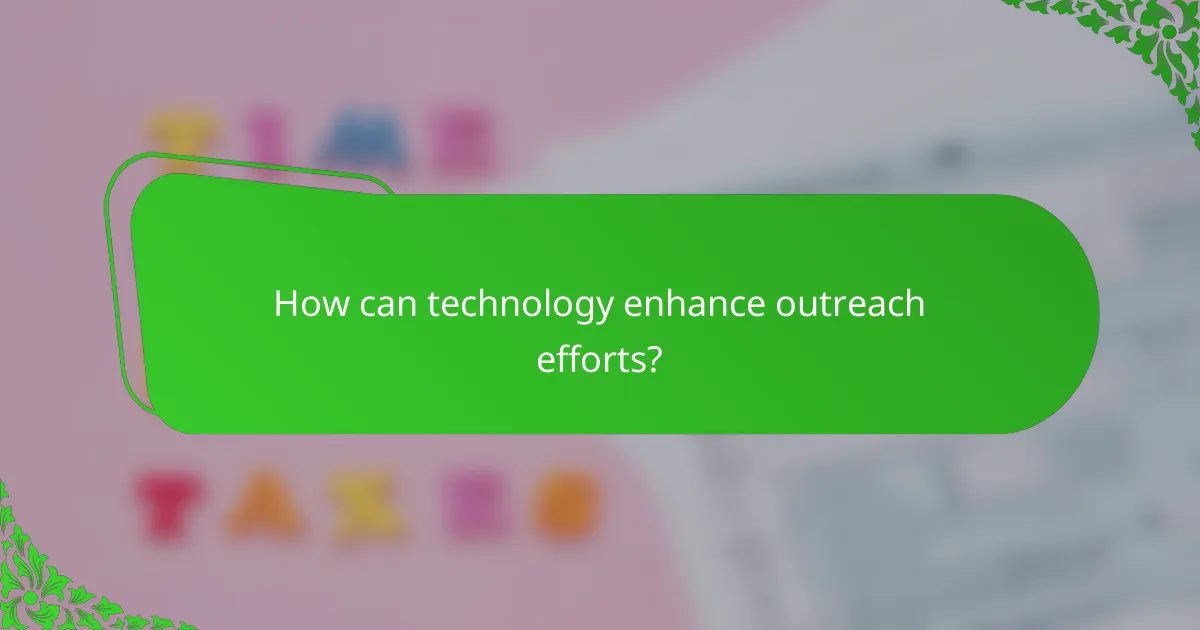
How can technology enhance outreach efforts?
Technology can significantly enhance outreach efforts by providing tools that facilitate communication, engagement, and data analysis. By leveraging digital resources, organizations can reach underrepresented groups more effectively and create inclusive environments for participation.
Digital platforms for engagement
Digital platforms serve as essential tools for engaging with diverse communities. Social media, email campaigns, and dedicated websites allow organizations to share information widely and interact directly with their audience. Platforms like Facebook, Twitter, and Instagram can be particularly effective in reaching younger demographics.
When selecting digital platforms, consider the preferences of your target audience. For instance, visual content may perform better on Instagram, while detailed information might be more suitable for email newsletters. Tailoring your approach to the platform can enhance engagement rates.
To maximize outreach, utilize analytics tools to track engagement metrics. Understanding which content resonates with your audience can inform future strategies. Regularly assess your digital presence and adjust your tactics based on feedback and performance data.

